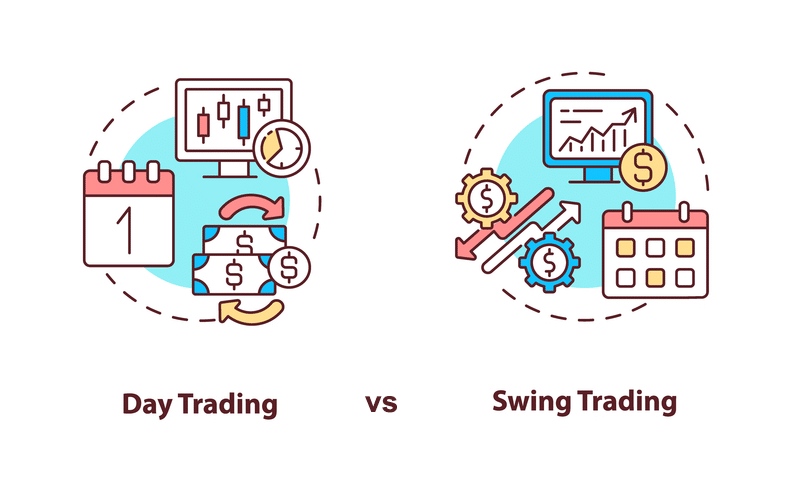
Day trading and swing trading, along with scalping, are the popular time frame-based strategies for trading the currency pairs. If you have been looking at both and thinking which one to choose, you have arrived at the right destination today — we will help you finally make up your mind.
How day trading works
Day trading is an approach whereby traders open their positions within one day’s trading session. In many instances, a day trader will open several positions to hedge risk and optimize a way of hedging risk.
Day traders often use a one percent risk rule, whereby whichever trade they open should not risk more than one percent of their investment portfolio. Using this rule, if a trader commits 0.2% of their capital on a trade and the market goes against them, they will lose 0.2%. However, if they had placed a position using a 3:1 risk-reward ratio, and the trade reached the profit target, traders would generate 0.6%.
Assuming they maintain this risk-reward ratio over a large sample of trades, traders can consistently generate significant profits, even if the win ratio is below 50%. When you look at it this way, day trading can be quite profitable. However, like any other investment venture, it isn’t without its downsides. Without the right trading expertise and strategy, you can easily run into losses.
How swing trading works
Unlike day trading, swing trading is conducted less frequently. Swing traders typically spread their trades by spacing them after several days, weeks, or months, depending on how their investment strategy is set. Swing trading is favorable to traders who are not keen on active trading, spending long hours in front of the screen.
Less frequent trading translates to less frequent accumulation of profit and less frequent exposure to losses. This, therefore, means that using the same amount of capital and assuming the same winning percentage for the two forms of trading, swing trading offers significantly less return potential than day trading.
Day trading and swing trading compared
Sufficient funding
You will need different amounts of capital depending on the asset class you trade and whether you are a day trader or a swing trader.
Below is a breakdown of how much you need to trade forex, stock, and futures.
Stocks
Legal regulations in the United States for day trading stocks require traders to have a minimum of $25,000 in their accounts. However, the same restrictions do not apply to the swing trading of stocks.
Forex
The forex market is comparatively more liberalized than futures and stock markets. Forex day traders and swing traders can start with as little capital as they wish. However, to generate meaningful profit, you would need the minimum account size of $1,000, and swing traders would need at least $1,500.
Futures
Futures are relatively more capital-intensive than forex. Standard contracts involving these assets will ideally require not less than $5,000 to make sizable returns as a day trader. However, there are smaller contracts that will require less capital to start.
Because swing trading is done less frequently than day trading, it is recommended that you start with at least $10,000. Remember that there will be different margin requirements per contract, which may dictate the minimum amount you need.
Time spent trading
As mentioned above, time is a significant point of divergence between day and swing trading. Below is a breakdown of how much time you need to spend on each type of trade:
Day trading
Day trading is quite demanding regarding the amount of time spent, conducting market research, studying charts and watching indicators, and employing technical analysis to prepare key entry and exit levels. All these may take at least an hour per trade.
If you open multiple positions, you will spend more time on analysis. After analysis, you will spend a couple of hours in front of the computer, watching the charts and looking for other opportunities to trade. In essence, day trading can easily become a full-time job.
Swing trading
Due to the less frequent nature of swing trading, it saves you a lot of time. More so if you use some of our swing trading tips. Typically, you will only need to spend about an hour each time you want to initiate a trade. Considering that you will only trade on a weekly or monthly basis, swing trading will allow you to concentrate on other tasks. Therefore, swing trading cannot be a full-time job.
When is day trading a good choice?
As discussed above, day trading can be just as profitable as it can be risky. This can leave you confused as to whether or not you should day trade. Below are guidelines to help you assess your preparedness for day trading.
Day trading is a good fit for you if you meet the following requirements:
- You have the minimum amount of capital required for you to trade in specific securities as per the Securities and Exchange Commission and FINRA regulations.
- You have the time and skills required to analyze the market and execute trades at a fast pace.
- You have a good understanding of the risk levels involved in day trading, and you are psychologically ready to take losses.
- You have the emotional strength to withstand the high-stress levels that can at times come with day trading.
- You fancy the idea of making small profits over several trades.
- You have the discipline needed to responsibly manage your profits and close your position when you meet your target.
When is swing trading a good choice?
Below is a checklist to use as a guideline for you if you intend to be a swing trader. Swing trading is a good choice under the following circumstances:
- You have the patience to wait for several weeks or even months for the market to move in your favor.
- You have limited capital to invest in securities.
- You are engaged in a full-time job and the amount of spare time you have cannot allow you to day trade.
- Your technical knowledge and analysis are not yet of expert level.
- You do not fancy the idea of spending much of your time in front of a computer monitoring market action.
- You are not willing or able to absorb frequent stress and expose your finances to risks on a frequently recurring basis.
Bottom line
Day trading and swing trading are proven and effective approaches to investment, and they can yield good returns if you have the time, resources, and skills needed. However, day trading is more demanding and requires a comparatively higher level of skills and capital. You should weigh your strengths and limitations before settling on either of them. Alternatively, you can employ both of them in your investment strategy.








Leave a Reply